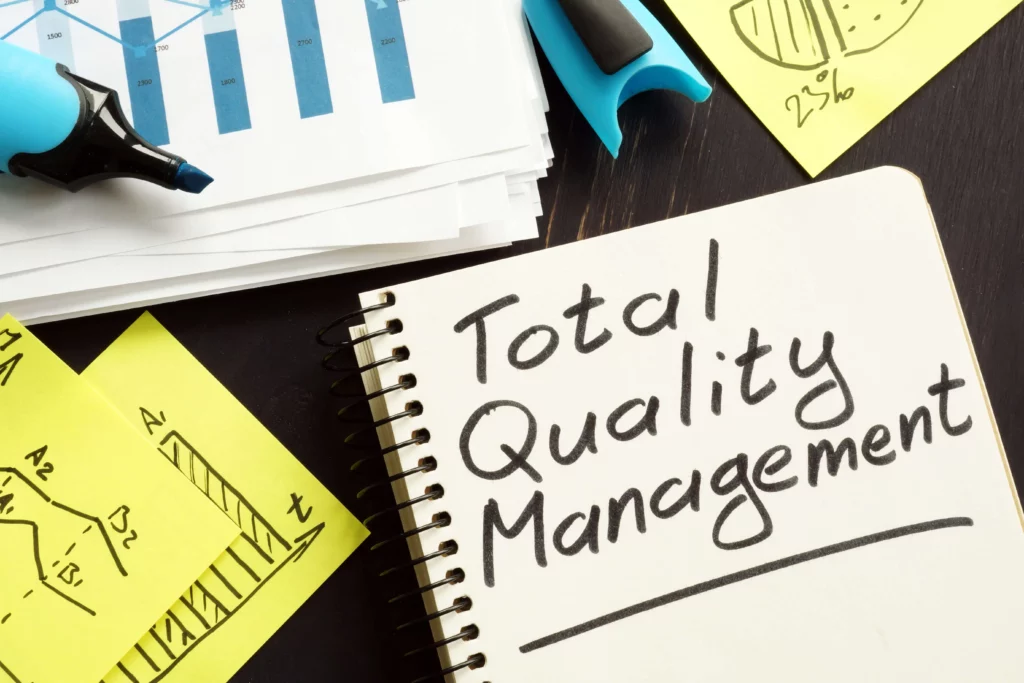What is Total Quality Management (TQM)?
Total Quality Management (TQM) is a management system and an ongoing process of improvement that focuses on enhancing the quality of products and services. TQM prioritizes customer satisfaction and requires all departments within an organization to work together towards a common objective. The core principle of TQM is that everyone involved in the production process, from design to delivery and customer service, has a responsibility for the quality of the final product or service.
TQM involves implementing a wide range of activities, including process improvement, quality assurance practices, supplier management, leadership development, employee training and development, and risk management. These activities are intended to take into account both internal (the company’s processes) and external factors (customer satisfaction). The goal of TQM is to continuously improve products and services through systematic measurement and feedback mechanisms throughout the organization.

Benefits of TQM for Businesses
Committing to the TQM process can come with multiple benefits for businesses, including enhanced customer satisfaction. By heeding customer feedback and adapting processes accordingly, companies can ensure they meet customer expectations consistently. This leads to the development of loyal customer relationships, which generates repeat business and higher profits.
In addition, TQM brings about improved productivity as it targets the elimination of waste at all production levels, leading to streamlined processes and reduced downtime. The streamlined processes enable employees to work more efficiently without compromising quality or safety standards, thereby increasing employee morale through improved working conditions and better resources for performing tasks effectively.
Moreover, by implementing Total Quality Management (TQM), organizations can save costs by allocating resources better and improving efficiency. Inefficient production systems lead to high material input and labor costs, which can be reduced through TQM implementation. The quality of products or services is not compromised even with these cost-saving measures, allowing businesses to maintain profitability and competitive pricing.

How to Implement TQM in Your Organization
To successfully implement TQM in your organization, several key steps should be taken:
1. Establishing Quality Management System (QMS): One way to ensure that everyone in the organization understands their roles and responsibilities for achieving quality objectives is to create QMS. This system should include tasks such as analyzing performance data, identifying areas for improvement, and developing corrective action plans. By implementing a QMS, it becomes easier to implement Total Quality Management (TQM).
2. Create Commitment from Senior Leaders: To ensure successful implementation, senior leaders must create an environment where everyone is committed to achieving excellence. This includes establishing expectations for everyone involved, setting achievable goals, and providing the resources necessary to reach those goals. Additionally, senior leadership must demonstrate their commitment by leading by example and encouraging others throughout the process.
3. Educate Employees: All employees need to understand how TQM works, so they can actively participate in improvement activities. Providing training sessions or workshops on various aspects of TQM is essential to ensure effective implementation across the entire organization. Training should include topics such as problem-solving techniques, root cause analysis tools, statistical process control methods, risk management practices, and more.
4. Define Goals & Measure Performance: Organizations must define clear goals related to quality objectives before beginning any improvement activities. These goals should be measurable, so progress can be tracked over time using quantitative measures such as defect rates or customer satisfaction surveys. It’s also important to identify potential obstacles early on, so they can be addressed quickly before they become major issues down the line.
5. Monitor & Modify Procedures: Once TQM has been implemented it’s important to monitor its effectiveness regularly, so any changes needed can be made quickly if necessary. This could involve tracking performance data or conducting surveys with customers or employees about their experience with the new system. By staying on top of progress it’s easier to identify problems early on which makes it easier to modify procedures if needed to achieve desired results.
By implementing total quality management in your organization, you can enjoy multiple benefits such as cost reduction, improved customer satisfaction, higher efficiency, better products or services, enhanced employee morale, increased innovation, and more. Following the steps mentioned above can steer you toward a successful implementation of TQM in your organization.

Key Principles for Successful Implementation of TQM
Total quality management (TQM) is an approach used to continually improve the overall quality of products and services. It is based on the idea that quality should be built into every aspect of a business’s operations and processes, rather than being inspected or tested afterward. The main goal of TQM is to increase customer satisfaction by delivering consistent, high-quality products and services. For a business to successfully implement TQM, several key principles must be followed:
1) Leadership: The first principle of successful TQM implementation is leadership. It is essential that the leaders within an organization provide clear direction and actively engage with their team to ensure that everyone understands the goals of TQM. Leaders must also create an environment where everyone feels free to contribute ideas and suggest improvements.
2) Customer Focus: A second key principle for successful TQM implementation is customer focus. Every decision made by the company should consider how it will impact both current and potential customers. This means taking into account customer feedback, as well as understanding what types of products or services they need to be satisfied with the results.
3) Continuous Improvement: A third important principle for the successful implementation of TQM is continuous improvement. This means consistently looking for ways to make processes more efficient, reduce costs, increase quality, and generally improve performance. Companies should set realistic but challenging goals, as well as regularly review their progress towards achieving them in order to ensure continuous improvement over time.
4) Teamwork: Finally, teamwork is a key principle for the successful implementation of TQM. Every employee should feel equally involved in the process of improving quality and striving toward excellence. This includes ensuring that each team member has access to necessary resources such as information, training, mentoring, and support from other departments when needed so they can best contribute their knowledge and skills to achieving organizational objectives related to total quality management (TQM).
By following these core principles, businesses can ensure that they are successfully implementing total quality management (TQM). Doing so can help them reduce costs, improve customer satisfaction levels and create a culture of continuous improvement within their organization – all leading towards greater success in terms of both profit margins and reputation among customers.

Creating a Culture of Continuous Improvement with TQM
The purpose of Total Quality Management (TQM) is to enhance the quality of products and services on an ongoing basis. It is a fundamental aspect of many business approaches, as it reduces expenses, elevates customer contentment, and establishes a culture of constant advancement in an enterprise. To guarantee the success of TQM, it is necessary to observe several central principles.
Creating a culture of continuous improvement requires that employees are actively engaged in the process. The first step in creating this culture is to ensure that everyone in the organization understands and believes in the benefits of TQM. This means providing training and education on the principles and processes involved in TQM, as well as reinforcing its importance throughout the entire organization. It also means involving staff in decision-making processes related to TQM initiatives, such as identifying areas for improvement or designing new processes or systems.
Another key principle is communication—both within the organization itself, as well as with external stakeholders such as suppliers and customers. Regular communication allows everyone involved to stay informed about changes being made within the organization, progress toward goals, and any issues that may arise during implementation. This can help ensure that everyone remains engaged and motivated throughout the process.
Organizations should also focus on measuring performance metrics associated with TQM initiatives. Measurements like customer feedback scores, defect rates or production efficiency can provide a clear indication of how successful implementation has been and what further steps need to be taken for continuous improvement. Additionally, organizations should look at their resources regularly to ensure they are being utilized effectively—this could include reviewing the availability of capital or operational capacities such as labor hours or inventory levels.
Finally, organizations should recognize successes achieved through the successful implementation of TQM initiatives—this includes rewarding staff members who successfully implement improvements or those who come up with innovative ideas during team meetings or brainstorming sessions. This serves to reinforce a culture where continuous improvement is valued and encouraged within the organization.




